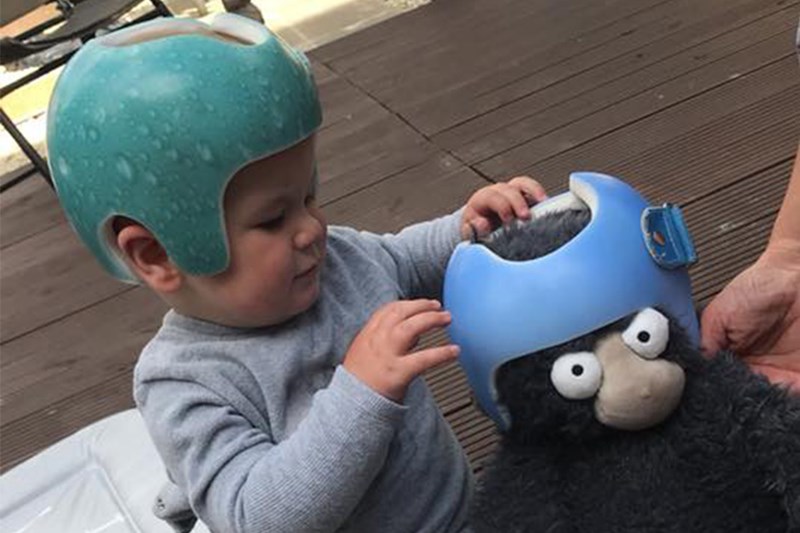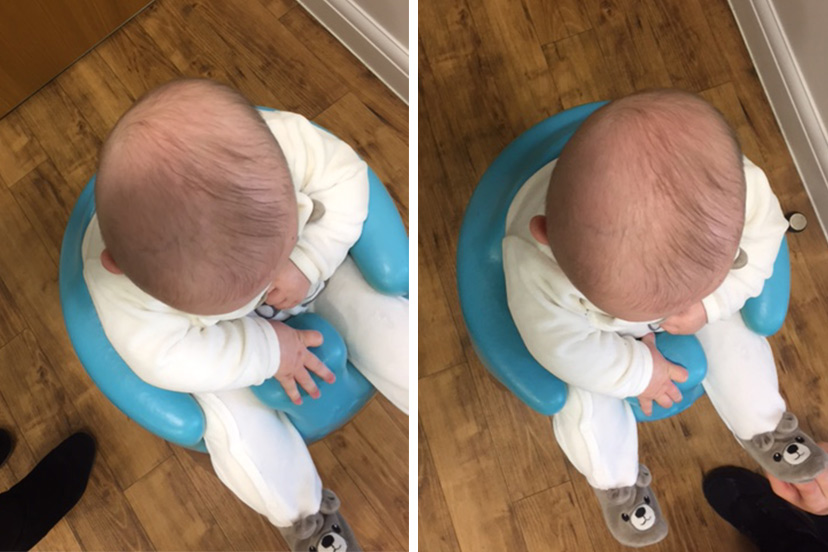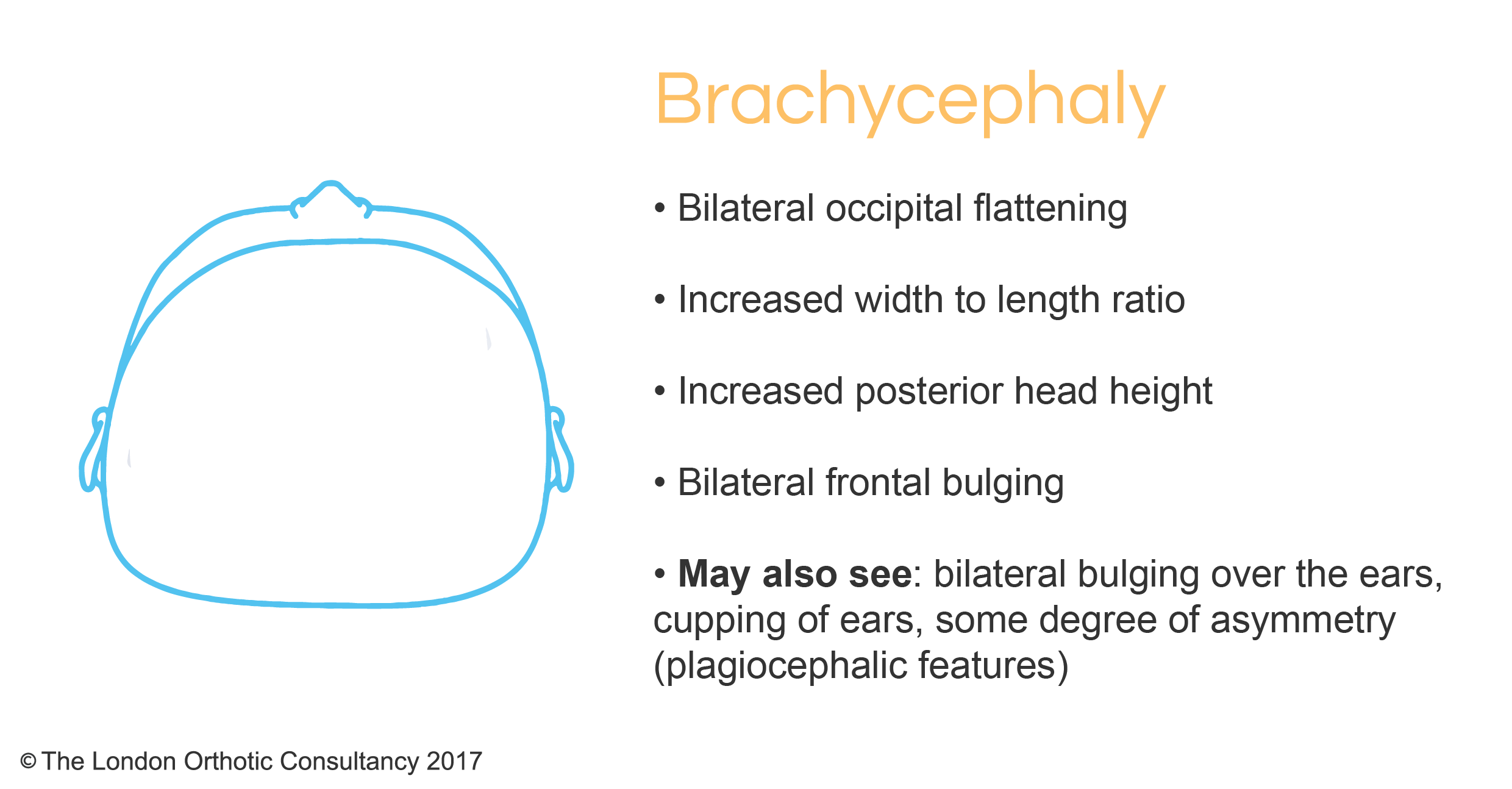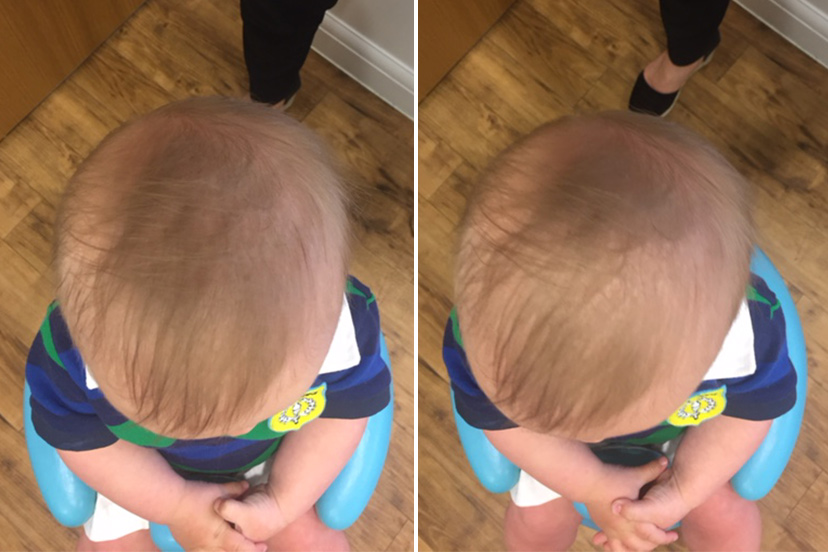
03 October 2018
Senior plagiocephaly clinician Sally Hews has treated a lot of babies for flat head syndrome in her time and has extensive experience in cranial remoulding therapy. Here, with the kind permission of Reggie’s parents, Sally shares his plagiocephaly journey.
Plagiocephaly or flat head syndrome is characterized by flat spots on the back or side of the head. Babies often develop flat spots when they are a few months old and they can be caused just by lying or sitting in the same position for too long; a hard surface, a car seat, cot. It occurs because a baby’s skull plates are not yet fully fused at birth, and are therefore soft enough to be moulded by exterior pressures and forces.

Above: Reggie's head shape before treatment
“Reggie was 4 months old when he first attended the London Orthotics Consultancy’s clinic in Harley Street.” Says Sally, “his parents were very worried about the shape of his head which they had noticed from the age of 6 weeks; they had actively repositioned him since they noticed his head shape but they felt it was having no effect and despite their efforts, he continued to sleep in the same position which was causing the head shape to worsen.

“Reggie had a marked plagiocephaly on his right side which was affecting his forehead and ear positon as well as the back of his head. He also had flatness at the back of his head, known as brachycephaly. Our clinical assessment confirmed that his head shape was severe and his parents felt they wanted to move forward with a helmet because other intervention had showed no benefit. Given the severity of his head shape I felt this was an appropriate step, in order to achieve the desired results.

Above: Reggie's head shape following treatment
“He was fitted with his LOCband two weeks later and took to the treatment immediately. His mother was reassured by the fact that he continued to sleep well with his helmet on and within weeks his asymmetry had improved rapidly.
“His parents felt he was doing so well and was happy wearing the band, so they decided to continue for 6 months and during this time his asymmetry reduced from 24mm to 6mm, a fantastic result.
He changed and developed so much during this time that the Reggie we discharged from treatment was a very different baby to the one who first came into our clinic!” says Sally.
If you think your baby might have plagiocephaly, you can quickly and easily get our clinical opinion for free with our Flat Head Syndrome diagnosis form where an experienced clinician – like Sally – will get back to you within 24 hours and advice whether it would be worth coming in for a free consultation in person.
This is very much dependent on how fast your baby is growing. The faster the growth, the more frequently your baby will be seen so that the helmet can be adjusted. In general, reviews will happen at two to four-week intervals.
The price of treatment covers:
Yes - All babies that have completed their course of treatment with us have achieved a measurable improvement in head shape. However, you don’t have to take our word for it.
Recent independent research conducted by a University Hospital in Germany has endorsed the treatment for babies with moderate or severe plagiocephaly.
A larger, retrospective study has just been published that found complete correction was achieved in 94.4% of babies treated with helmet therapy.
The results were conclusive: repositioning achieved acceptable correction in 77.1% of cases, but 15.8% were moved onto helmet therapy because re-positioning was not working. Meanwhile, 94.4% of the infants who started in the helmet-treated group achieved full correction, as did 96.1% of those who were transferred from the repositioning group into the helmet-treated group.
Further information can be found on our Plagiocephaly Research page.
If your baby has a temperature or a fever due to illness you must remove the band. The band can be put back on once the temperature has returned to normal.
The optimum age for treatment is between four and seven months.
This is because the skull is most malleable at this age and improvements to head shape tend to take less time and are more dramatic. That is not to say that helmet therapy should be ruled out if the baby is older than seven months. Routinely, babies up to the age of 16 months can be treated very successfully.
The cut off age is around 18 months when the fontanelles (soft spots on the head) are no longer malleable. As babies grow and develop at different rates, it is always worth checking if you are not sure. There have been cases where a baby’s fontanelles have not fused yet by the age of 18 months, who have achieved successful, but less-marked results with cranial remoulding therapy.
Torticollis is a condition in which a tight or shortened muscle in one side of the neck causes the head to tilt or turn to one side, resulting in the infant resting its head in the same position. In 2013, we analysed the data from all first appointments in our Kingston clinic and found that 20% of the babies examined had some kind of neck condition that was causing head immobility.
The clinics and clinicians that provide this treatment in the UK will have received similar training and experience. However, we are the only clinic that manufactures its own helmet and our clinicians are closely involved with the process for each individual helmet that we produce.
In addition, we do not restrict review appointments to a set number, we are extremely flexible and respond to individual parents' needs so that the best outcome can be achieved for each baby.
The LOCband is non-invasive and works by applying gentle, constant pressure over the areas of the baby’s skull that are most prominent while allowing unrestricted growth over the flattened areas. The band consists of a soft foam layer inside a thermoplastic shell. As the baby grows, the band will be adjusted frequently to gently guide the skull into a more symmetrical shape.